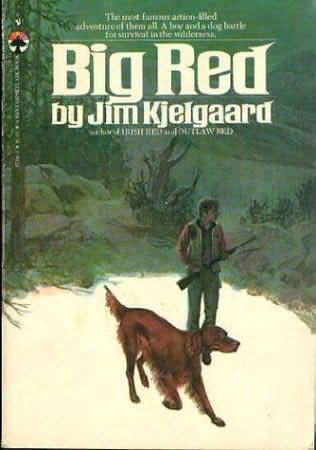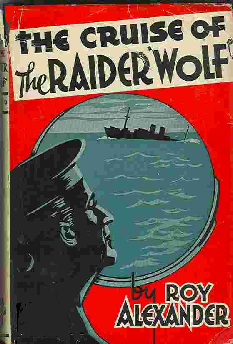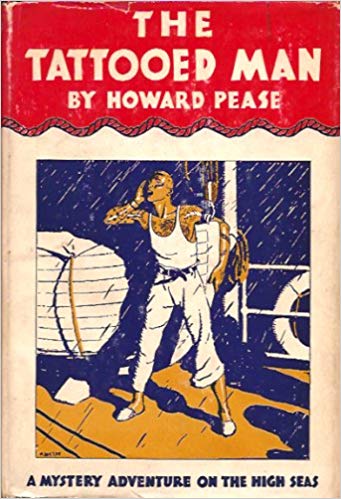Ages Three to Seven:
I can’t remember much from ages three to seven, except it was a very pleasant childhood. Mom, contrary to conventional wisdom, taught me to read well before I entered kindergarten and always provided me with an ample supply of books. Professional educators in those days discouraged the practice, but it was perhaps the most important lesson I learned in early childhood and has served me well for over seventy years. As a young boy, a few of my favorites I read and re-read many times over were:
Big Red by Jim Kjelgaard

Big Red a wonderful book about a young man and his dog, a champion Irish Setter. Although Danny doesn’t own him, it is his job to take care of Red. The book was written by Jim Kjelgaard in 1945, so the reader must picture a time when life was a little simpler. Ross is a trapper and they live without running water and electricity in a small shack in the woods.
Having been written in the 1940’s, this book does not look at the world that we see it today. Danny has grown up with a trapper for a father, and he is a trapper himself. Danny is often with a gun, especially when he takes Red out partridge hunting. They often find themselves in trouble either with a bear, a wolverine, or just the hardship of life living out in the wilderness.
The Cruise of the Raider Wolf by Roy Alexander

The Cruise of the Raider “Wolf” is not intended as another war book; it is the story of one of the strangest and greatest sea adventures of modern times.
The Wolf has become a legendary figure—a name connected with strange happenings at sea; but to most people it is only a name. The actual cruise was a shadowy, mysterious affair; and for many reasons the history of the cruise has remained equally vague. Briefly, this raider slipped out of Germany in 1916, and for fifteen months roamed the seas of the world depending for fuel and food on the captures she made.
Her very existence depended on these captures not becoming known. Ships encountering the Wolf therefore simply disappeared, their fate unknown. The raider roamed the Atlantic, Indian, Pacific oceans, even touched the Arctic and Antarctic seas. And she capped this unparalleled cruise by running the blockade back to Kiel.
Incidentally, the Wolf was the only enemy warship to enter Australian or New Zealand waters. She mined the coasts of both these countries.
After the raider’s return to Germany there was a world-wide blaze of publicity. The reception of the Wolf’s men in Berlin was one of the outstanding war events in the German capital. Then the Wolf disappeared from public notice as quickly as she became famous. One reason for this was that Captain Nerger, the raider’s commander, was not a publicity seeker and was not in particularly high favor in Germany. It was necessary to receive him with honor after he brought his ship back from such a cruise, but after that he was quietly moved to an obscure post and was heard of no more.
The author was a prisoner aboard the raider for the last nine months of the cruise.
Sea Wolf Jack London

The novel begins when Van Weyden is swept overboard into San Francisco Bay, and plucked from the sea by Larsen’s seal-hunting vessel, the Ghost. This ship’s evil captain, Wolf Larsen – The Sea-Wolf – is a murderous tyrant who uses his superhuman strength to torture and destroy, his brilliant mind to invent sick games, and his relentless will to control his mutinous crew. Pressed into service as a cabin boy by the ruthless captain, Van Weyden becomes an unwilling participant in a brutal shipboard drama. Larsen’s increasingly violent abuse of the crew fuels a mounting tension that ultimately boils into mutiny, shipwreck, and a desperate confrontation.
White Fang Jack London

In the
desolate, frozen wilds of northwest Canada, White Fang, a part-dog, part-wolf
cub soon finds himself the sole survivor of a litter of five. In his lonely
world, he soon learned to follow the harsh law of the North—kill or be killed.
But nothing in his young life prepared him for the cruelty of the bully Beauty
Smith, who buys White Fang from his Indian master and turns him into a vicious
killer—a pit dog forced to fight for money.
Will White Fang ever know the kindness of a gentle master or will he die a
fierce deadly killer?
A classic adventure novel detailing the savagery of life in the northern wilds.
Its central character is a ferocious and magnificent creature, through whose
experiences we feel the harsh rhythms and patterns of wilderness life among
animals and men.
The Tattooed Man by Howard Pease

A tale of strange adventures, befalling Tod Moran, mess boy of the tramp steamer “Araby,” upon his first voyage from San Francisco to Genoa, via the Panama Canal.
This book is the first in a series about the same characters. It has mystery, not over-hyped, and authenticity. I like fantasy fiction all right, but there must still be a place for realistic non-urban, pre-computer reading material about adventure as well. Pease can be a bridge for tweens to Stevenson and Conrad.
I found it interesting the review pointed out the bridge to Stevenson and Conrad because that’s exactly what happened. I progressed from The Tattooed Man by Howard Pease to Lord Jim by Joseph Conrad and Treasure Island by Robert Louis Stevenson.
One of the most memorable gifts I received when I was about six or seven years old was contained in a large heavy box (very large and heavy to me at the time) which sat under the Christmas tree for about a week before Christmas. On Christmas morning, I opened the box and it was full of books on a wide variety of subjects. I was enthralled. It kept me busy for many months and believe it or not I’ve referred to those books well into adulthood and many I still have.
Mom also was my biggest cheerleader for my early interest in art. I showed a talent for drawing at an early age and this ability was encouraged and enthusiastically promoted by my Mom. My Dad, not so much, as he basically could never draw a straight line. But Mom was my biggest fan and ardent supporter. Creative inspiration came from the old oil paintings stored in our attic that were painted by my Father’s Father, Grandpa Gunardson. His oil paints and brushes were there as well; the original tools that led to my first forays into oil painting. To my Dad’s credit, even though he didn’t directly encourage my artistic efforts very much, he built me an artist’s easel for my seventh birthday that I used all of my life and is now in the storage.
In addition to my Grandfather’s oil paints there were several other items that had a profound influence on me. They were the scale model boats he built from scratch and the model steam engines for the boats. As I recall from my Mom and Dad, before he retired and went “shore side” my Grandfather Gunardson, was a steamfitter aboard large cargo ships, freighters as they were called. He spent his spare time building the model boats and engines. And there was also a huge collection of books. Among them are the complete works of Mark Twain, Alexander Dumas and Joseph Conrad as well as Encyclopedias of Natural History and many assorted works of fiction by Jack London and other classics. I spent many, many hours poring over those old books time and again. Later in life I never hesitated to add to those early collections and never regretted the money I spent on books. I always and still do regard it as money well spent.
Now approaching seventy-two years old and living in the relatively cramped quarters of my sailboat “Free Radical” I often wonder what to do with all those books. To me they are and have always been more than just old books. To a large extent they influenced my childhood, my teenage years and are in many ways are a snapshot of who I eventually grew up to be. But In today’s electronic age they are mere artifacts. Just old books. That’s all. And they take up a lot of space, space unavailable in the confined quarters of a sailboat. There are only a very few regrets I’ve had in my decision to live aboard the boat, but one of them is I miss those books.
On a recent visit, Jill and I were having a conversation that somehow drifted to the subject of all those books in the “storage”. I lamented that I really didn’t know what to do with them. There is no room on the boat and they’re just taking up space in storage. Jill commented, “Yeah, there sure are a lot of them, and some pretty weird genre’s, like “In Patagonia”, “Climbing Ice” and “How to Survive a Grizzly Bear Attack”. She was right about that. I thought about donating them to an old age home or a hospital library but the readers in those venues probably wouldn’t have much interest in titles like “Climbing Ice” for instance or a how-to manual on avoiding grizzly bear attacks.
What else was in that treasure trove I inherited from my Grandfather? There were tools of all sorts many of which I still have (in storage and a few on board the boat) and there is the exceptionally large harmonica that I unfortunately never learned to play, although I tried and failed. There was the antique 22 rifle, that I eventually gave to my son Jim. But I’d say the items I inherited that had the most influence in no particular order of priority were the books, the oil paints, the model engines, the tools and the model boats (well on second thought probably the boats top the list).
My Father was also fond of boats, not models, but power boats which I spent most of my teenage years messing around in. Boats were always present, in the past, in the present and without doubt will continue to be in my future. I guess it was inevitable I would eventually become an old guy still just messing around with boats. When I was a small child friends and family would inevitably ask, “What do want to be when you grow up?” and I would always answer, I want to be a merchant seaman. Well I never became a merchant seaman, but I did end up living aboard a boat.
One of my favorite nautical authors, Bernard Moitessier, when asked why he left shore to go on a small sailboat to sea for months on end said, “You do not ask a tame seagull why it needs to disappear from time to time toward the open sea. It goes, that’s all”. Nuff said.
So long, good luck and have a nice day…
